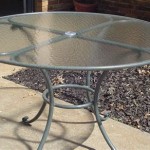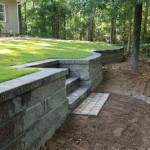How To Repair Patio Stones
Patio stones, also known as pavers, provide an attractive and durable surface for outdoor living spaces. However, exposure to the elements, heavy foot traffic, and settling soil can lead to cracking, shifting, and other forms of damage. Timely repairs are crucial to maintain the structural integrity and aesthetic appeal of a patio. This article will provide a comprehensive guide on how to effectively repair patio stones, covering various types of damage and the appropriate repair techniques.
Assessing Patio Stone Damage
Before undertaking any repair work, it is essential to thoroughly assess the extent and nature of the damage. This assessment will determine the necessary tools, materials, and repair methods. Common types of patio stone damage include:
*Cracked Stones:
Cracks can range from hairline fractures to significant breaks that compromise the stone's structural integrity. Minor cracks may be caused by thermal expansion and contraction, while larger cracks often result from impact or underlying soil movement. *Loose or Shifting Stones:
Stones that have become loose or have shifted from their original positions create uneven surfaces and potential tripping hazards. This is often caused by erosion of the base material or inadequate edge restraints. *Sunken Stones:
Sunken stones create depressions in the patio surface, leading to water pooling and further exacerbating the problem. This is typically caused by compaction of the underlying soil or improper base preparation during the initial installation. *Chipped or Spalled Stones:
Chipping or spalling, where the surface of the stone flakes away, is often caused by freeze-thaw cycles, de-icing salts, or physical impact. *Staining and Discoloration:
Stains from spills, organic matter, or efflorescence can detract from the patio's appearance. While not technically damage to the structure, addressing stains is often part of a comprehensive patio restoration project.A careful inspection should identify the specific types of damage present and their severity. Documenting the findings with photographs can be helpful for planning and tracking the repair process.
Repairing Cracked Patio Stones
The approach to repairing cracked patio stones depends on the severity and extent of the cracks. Minor hairline cracks may be addressed with patching compounds, while more significant cracks may require stone replacement.
Repairing Minor Cracks:
For hairline cracks that do not significantly affect the stone's structural integrity, a concrete patching compound can be used. The process involves:- Cleaning the cracked area thoroughly to remove any loose debris, dirt, or vegetation. A wire brush or pressure washer can be used for this purpose.
- Applying a concrete bonding adhesive to the crack to improve the adhesion of the patching compound.
- Mixing the concrete patching compound according to the manufacturer's instructions.
- Filling the crack with the patching compound, ensuring it is level with the surrounding surface.
- Allowing the patching compound to cure completely according to the manufacturer's instructions, typically 24-48 hours.
- Sanding the patched area smooth to blend with the surrounding surface.
- Sealing the patched area to protect it from moisture and further damage.
Replacing Severely Cracked Stones:
When a patio stone is severely cracked or broken, replacement is the most effective solution. The process involves:- Wearing appropriate safety glasses and gloves, Carefully removing the damaged stone using a hammer and chisel. Take care not to damage the surrounding stones.
- Cleaning the area beneath the removed stone, removing any loose debris, sand, or gravel.
- Adding a layer of compacted sand or gravel to the base to ensure a level surface.
- Placing a new stone that matches the size, shape, and color of the original stone.
- Ensuring the new stone is level with the surrounding stones. Use a rubber mallet to gently tap the stone into place.
- Filling the joints around the new stone with polymeric sand to provide stability and prevent weed growth.
- Watering the polymeric sand according to the manufacturer's instructions to activate the bonding agents.
It is important to match the replacement stone as closely as possible to the existing stones to maintain the aesthetic consistency of the patio. If exact matches are unavailable, consider using stones from a less visible area of the patio, or purchasing new stones for the entire area to achieve a uniform appearance.
Repairing Loose, Shifting, or Sunken Patio Stones
Loose, shifting, or sunken patio stones indicate an unstable base. Correcting this issue requires re-leveling the affected area and ensuring a solid foundation.
Re-Leveling Stones:
The process involves:- Carefully removing the affected stones, setting them aside for reuse.
- Examining the base material beneath the stones. If the base is compacted or uneven, it needs to be re-graded.
- Adding or removing base material (typically sand or gravel) to create a level surface. Use a level and tamper to ensure the base is properly compacted and level.
- Replacing the stones, ensuring they are level with the surrounding stones. Use a rubber mallet to gently tap the stones into place.
- Checking the alignment of the stones and making any necessary adjustments.
- Filling the joints between the stones with polymeric sand to provide stability and prevent weed growth.
- Watering the polymeric sand according to the manufacturer's instructions.
For larger areas with widespread settling, it may be necessary to remove all the stones, re-grade the entire base, and reinstall the stones. This will ensure a uniform and stable patio surface.
Addressing Edge Restraints:
Edge restraints are crucial for preventing patio stones from shifting and spreading. If the existing edge restraints are damaged or inadequate, they should be repaired or replaced. Options for edge restraints include plastic edging, concrete curbing, or interlocking paver edging. The type of edge restraint selected should be appropriate for the size and configuration of the patio.Addressing Staining and Discoloration
While not structural damage, stains and discoloration detract from the appearance of patio stones. Various cleaning methods and products can be used to remove stains and restore the stones' original color.
Cleaning Stains:
The approach to cleaning patio stones depends on the type of stain:-
Organic Stains (e.g., leaves, algae):
These stains can often be removed with a mixture of water and mild detergent. A scrub brush can be used to agitate the stained area. For more stubborn stains, a solution of bleach and water (diluted appropriately) can be used, but it is important to test the solution in an inconspicuous area first to ensure it does not damage the stones. -
Oil and Grease Stains:
These stains require a degreasing agent specifically designed for concrete or stone. Apply the degreaser according to the manufacturer's instructions, allowing it to dwell on the stain for the recommended time before scrubbing and rinsing. -
Rust Stains:
Rust stains can be removed with a rust remover specifically designed for concrete or stone. Follow the manufacturer's instructions carefully, and test the solution in an inconspicuous area first. -
Efflorescence (White Mineral Deposits):
Efflorescence is a white, powdery deposit that can appear on the surface of concrete or stone. It is caused by soluble salts migrating to the surface and can be removed with a stiff brush and a solution of water and vinegar (diluted appropriately).
Pressure washing can be an effective way to clean patio stones, but it is important to use the correct pressure setting and nozzle to avoid damaging the surface. Always test the pressure washer in an inconspicuous area first. Avoid using harsh chemicals or abrasive cleaners, as these can damage the stones.
Sealing Patio Stones:
Applying a sealant to patio stones can help prevent staining and discoloration by creating a protective barrier against moisture and contaminants. Sealants can be penetrating sealants, which soak into the stone and provide protection from within, or film-forming sealants, which create a protective layer on the surface of the stone. The type of sealant selected should be appropriate for the type of stone and the desired level of protection. Follow the manufacturer's instructions carefully when applying the sealant.Preventative Maintenance
Preventative maintenance is key to prolonging the life of a patio and minimizing the need for repairs. Regular maintenance tasks include:
*Sweeping the Patio:
Regularly sweeping the patio to remove dirt, leaves, and debris prevents the buildup of organic matter that can stain the stones. *Cleaning Spills Promptly:
Cleaning spills immediately prevents staining and makes it easier to remove the stain. *Sealing the Patio:
Applying a sealant every few years provides a protective barrier against moisture and contaminants. *Controlling Weeds:
Removing weeds from the joints between the stones prevents them from destabilizing the base. *Inspecting the Patio Regularly:
Regularly inspecting the patio for signs of damage allows for early detection and repair, preventing minor problems from becoming major issues.By following these preventative maintenance tips, homeowners can keep their patios in good condition and avoid costly repairs.

How To Repair Sinking Patio Pavers Diy

How To Repair A Patio S Grouting Sinking Checkatrade

Fix Your Rocking Patio Slabs With This Easy Solution

How To Repair Stone Walkway Mortar This Old House

How To Repair Sinking Patio Pavers Splendour In Stone

How To Repair Sinking Patio Pavers Diy

How Can I Repair Some Broken Patio Stones Home Improvement Stack Exchange

Raise Sunken Patio Pavers

How To Repair Loose Paving Stones Patio

How To Repair Stone Walkway Mortar This Old House
Related Posts








